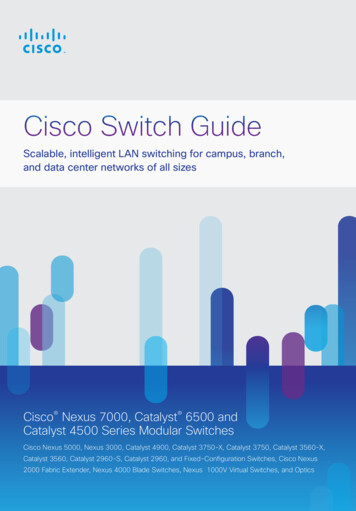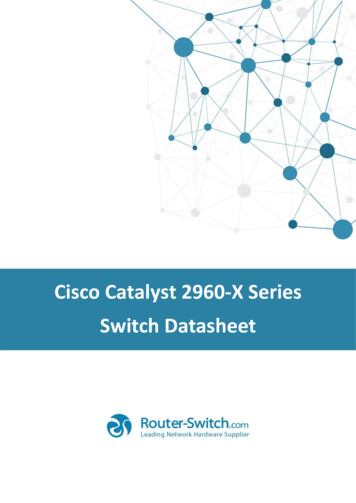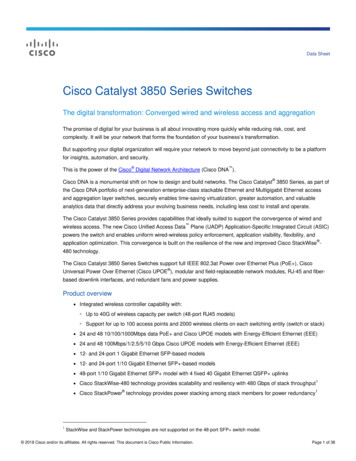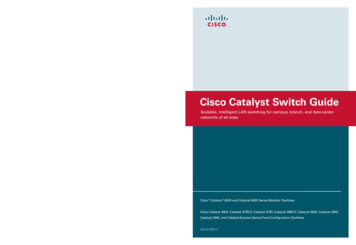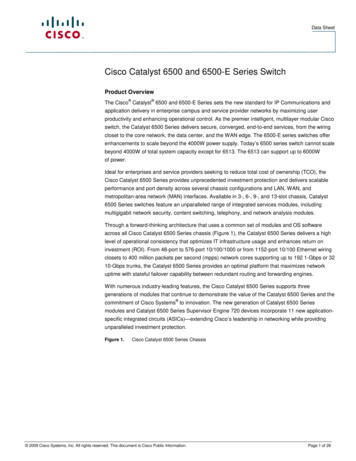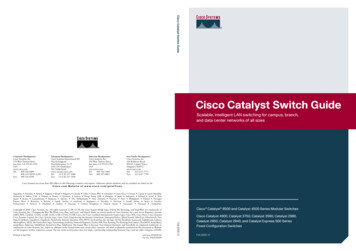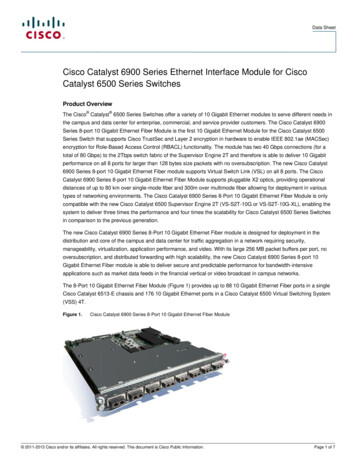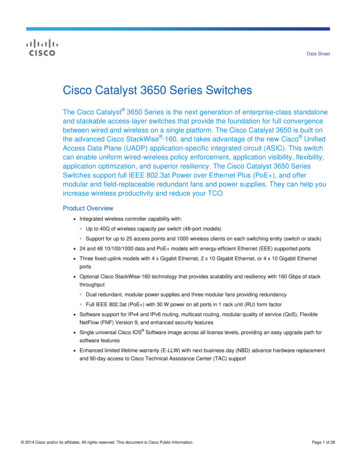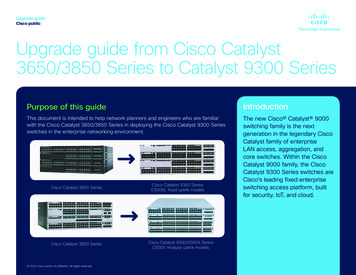
Transcription
Upgrade guideCisco publicUpgrade guide from Cisco Catalyst3650/3850 Series to Catalyst 9300 SeriesPurpose of this guideIntroductionThis document is intended to help network planners and engineers who are familiarwith the Cisco Catalyst 3650/3850 Series in deploying the Cisco Catalyst 9300 Seriesswitches in the enterprise networking environment.The new Cisco Catalyst 9000switching family is the nextgeneration in the legendary CiscoCatalyst family of enterpriseLAN access, aggregation, andcore switches. Within the CiscoCatalyst 9000 family, the CiscoCatalyst 9300 Series switches areCisco’s leading fixed enterpriseswitching access platform, builtfor security, IoT, and cloud.Cisco Catalyst 3650 SeriesCisco Catalyst 3850 Series 2022 Cisco and/or its affiliates. All rights reserved.Cisco Catalyst 9300 SeriesC9300L fixed uplink modelsCisco Catalyst 9300/9300X SeriesC9300 modular uplink models
Upgrade guideCisco publicContentsIntroductionPurpose of this guideWhy upgrade?System hardwareSystem default behaviorHigh availability – StackWise1T/480/320 and StackPower PlusOperationsInterface referenceManagement interfaceSoftware featuresHost tracking featureQuality of serviceCongestion avoidanceConclusionAppendix AWhy upgrade?The Cisco Catalyst 9300 Series switches are Cisco’s leading fixed enterprise switching access platform,built for security, mobility, IoT, and cloud. These switches form the foundational building block for CiscoSoftware-Defined Access (SD-Access), Cisco’s lead enterprise architecture.The Cisco Catalyst 9300 Series is the industry’s first optimized platform for WiFi-6/WiFi-6E and 802.11acWave 2, with support for 2.5G, 5G and Multigigabit downlinks and 802.3 BT complaint up to 90W PoE(Cisco UPOE ). It provides support for the highest density WiFi-6/WiFi-6E and 802.11ac Wave 2 (48access points) in a single-Rack-Unit (RU) box. The Cisco Catalyst 9300 Series has the most flexibleuplink architecture, with 9300X models supporting Multigigabit, 10Gbps, 25Gbps, 40Gbps and 100Gbpsuplinks and C9300 modular uplink models supporting 1 Gbps, Multigigabit, 25Gbps, and 40 Gbpsuplinks. The platform also offers flexible downlink architecture with fiber ports supporting 1G/10G/25GFiber speeds and Multigigabit (1G/2.5G/5G/10G) copper ports with industry’s highest 1Tbps stackingbandwidth. The Cisco StackWise -1T architecture provides unparalleled scale (448 ports per stack) andflexibility of deployment for the platform, with support for the best Nonstop Forwarding (NSF)/StatefulSwitchover (SSO) resiliency architecture for a stackable solution.The Cisco Catalyst 9300 Series also has a highly resilient and efficient power architecture with CiscoStackPower technology, which delivers a high density of Cisco UPOE , UPOE and PoE ports. Theswitches provide unmatched PoE resiliency capabilities, such as Perpetual and Fast PoE, optimizing themfor Smart Building deployments. They support the most efficient power supplies in the industry.The Cisco Catalyst 9300 Series Switches are also built with the latest Cisco Unified Access Data Plane2.0 (UADP 2.0) Application-Specific Integrated Circuit (ASIC) for 9300 (Modular and Fixed uplink models)and Cisco UADP 2.0sec ASIC for 9300X models with an x86-based CPU running on open Cisco IOS XESoftware, a converged operating system. Together they deliver model-driven programmability, streamingtelemetry, third-party container-based app hosting, application visibility, stronger security with 256-BitMACsec link encryption, Hardware Layer 3 encryption (IPSEC) up to 100G and Encrypted Traffic Analytics(ETA), support for higher bandwidth uplinks, and a more advanced operating system than the CiscoCatalyst 3850 or 3650 Series switches.System hardwareThe Cisco Catalyst 9300 Series is based on Cisco’s UADP ASIC architecture and an x86 CPUarchitecture. 9300X models have Cisco’s UADP 2.0sec ASIC while 9300 modular uplinks and fixeduplinks models have UADP 2.0. It also provides options for additional internal and external storage upto240GB SSD, which enables the device to host containers and run third-party applications and scriptsnatively within the switch. Tables 1 and 2 list some of the system hardware differences between theCisco Catalyst 3850 Series and Catalyst 9300 Series. 2022 Cisco and/or its affiliates. All rights reserved.
Upgrade guideCisco publicContentsTable 1.Comparison of the Cisco Catalyst 3650 Series and Catalyst 9300 - fixed uplink C9300L hardwareIntroductionCatalyst 3650 SeriesCatalyst 9300 - C9300L SKUsPurpose of this guideCPUQuad-corex86 Quad-coreWhy upgrade?SDRAM4 GB8 GBSystem hardwareInternal flash2/4 GB16 GBExternal storage16 GB240 GBSystem default behaviorHigh availability – StackWise1T/480/320 and StackPower PlusOperationsTable 2.Comparison of the Cisco Catalyst 3850 Series and Catalyst 9300 Series - modular uplink C9300 hardwareInterface referenceManagement interfaceSoftware featuresHost tracking featureQuality of serviceCongestion avoidanceCatalyst 3850 SeriesCatalyst 9300 - C9300 SKUsCPUQuad-corex86 Quad-coreSDRAM4 GB8 GB/16G (9300X models)Internal flash2/4/8 GB16 GBExternal storage16 GB240 GBConclusionAppendix ASystem default behaviorThe system default behavior on the Cisco Catalyst 9300 Series is very much the same as that of theCisco Catalyst 3650/3850 Series. For example, interfaces default to Layer 2 switch port mode, IProuting is disabled, the management interface is in a dedicated Virtual Routing and Forwarding (VRF)instance, and so on. However, there is one difference in the control plane policy when the Catalyst3650/3850 Series is running Release 3.X. Control Plane Policing (CoPP): CoPP is enabled on the Cisco Catalyst 9300 Series with defaultpolicing rates for different classes of traffic. These policing rates are optimized for a typical campusenvironment. The policing rates can be changed or disabled for different application environments.On the Cisco Catalyst 3650/3850 Series, CoPP is not enabled by default, but the system provides amacro to create the different classes, and the user can specify the policing rate for different classes. 2022 Cisco and/or its affiliates. All rights reserved.
Upgrade guideCisco publicContentsIntroductionPurpose of this guideWhy upgrade?System hardwareSystem default behaviorHigh availability – StackWise1T/480/320 and StackPower PlusOperationsInterface referenceManagement interfaceSoftware featuresHost tracking featureQuality of serviceCongestion avoidanceHigh availability – StackWise-1T/480/320 andStackPower PlusThe Cisco Catalyst 9300 Series provides robust high availability features as the Cisco Catalyst 3650/3850Series with increased stack bandwidth. Catalyst 9300X models support Stackwise-1T, Catalyst 9300Series switches with Modular uplinks support Stackwise 480 while switches with fixed uplinks (9300L)support Stackwise-320. In StackWise-1T/480/320, eight switches can be stacked together to form asingle logical switch, and both SSO and NSF mechanisms are supported during failovers. Catalyst 9300supports Extended Fast Software Upgrade (xFSU) to decrease the traffic downtime to less than 30 secs.This capability does not exist on Catalyst 3850/3650 series. For customers migrating from 3850 Seriesstacks to Catalyst 9300 Series stacks, the same stacking cables can be used for stacking C9300 models.For customer migrating from Catalyst 3650 Series stacks to C9300L stacks, optional stack kit has to beordered separately for Stackwise-320.The Cisco Catalyst 9300 Modular uplink models support the Cisco StackPower feature and 9300Xmodels support StackPower Plus for power redundancy, enabling four switches to be stacked together ineither combined or redundant mode. In an eight-member stack, two power stacks of four switches eachcan be configured for power redundancy. Table 3 and 4 compares the power redundancy features ofthe Cisco Catalyst 3650/3850 Series and Catalyst 9300 Series. Catalyst 9300 Series switches with fixeduplinks (C9300L) do not support StackPower.Table 3.Comparison of the Cisco Catalyst 3850 Series and 9300 Modular Uplinks power redundancyConclusionCatalyst 3850 SeriesCatalyst 9300 Series- C9300 SKU’sStackwise-1TNA8 (9300X models)StackWise-4808 or 9, depending on the model8StackPower44Number of power supply slots22Power supplies Appendix A 2022 Cisco and/or its affiliates. All rights reserved.350W AC715W AC1100W AC715W DC 350W AC715W AC1100W AC715W DC1900W AC
Upgrade guideCisco publicContentsIntroductionPurpose of this guideCatalyst 3850 SeriesCatalyst 9300 Series- C9300 SKU’sSystem power and PoE powerEach power supply has a fixedamount of system power and afixed amount for PoEEach power supply has a fixedamount of system power and afixed amount for PoEPower redundancyCombined redundantCombined redundantWhy upgrade?System hardwareSystem default behaviorHigh availability – StackWise1T/480/320 and StackPower PlusOperationsInterface referenceManagement interfaceSoftware featuresTable 4.Comparison of the Cisco Catalyst 3650 Series and 9300L Power RedundancyCatalyst 3650 SeriesCatalyst 9300 - C9300L rNoNoNumber of power supply slots22Power supplies System power and PoE powerEach power supply has a fixedamount of system power and afixed amount for PoEEach power supply has a fixedamount of system power and afixed amount for PoEPower redundancyCombinedCombinedHost tracking featureQuality of serviceCongestion avoidanceConclusionAppendix A250W AC640W AC1025W AC640W DC 350W AC715W AC1100W AC715W DCOperationsInterface referenceCisco Catalyst 3650/3850 Series Multigigabit switches have Gigabit Ethernet and 10G Ethernet ports only.Cisco Catalyst 9300 Series Multigigabit switches have introduced support for 1G, 2.5G, 5G and 10GEthernet on the 48-port Multigigabit switches (Table 5).Table 5.Presence of 2 Gigabit Ethernet ports on the Cisco Catalyst 3850 Series and Catalyst 9300 Series2.5 GigabitEthernet ports 2022 Cisco and/or its affiliates. All rights reserved.Catalyst 3650/3850 SeriesCatalyst 9300 SeriesNoneTw1/0/1
Upgrade guideCisco publicContentsIntroductionPurpose of this guideWhy upgrade?System hardwareSystem default behaviorHigh availability – StackWise1T/480/320 and StackPower PlusOperationsInterface referenceManagement interfaceSoftware featuresHost tracking featureQuality of serviceCongestion avoidanceConclusionAppendix AManagement interfaceThe management interface on the Cisco Catalyst 9300 Series is Gigabit Ethernet, which is very similarto the Gigabit Ethernet interface on the Catalyst 3650/3850 Series. The management port on bothplatforms has its own VRF instance for separation of management traffic from normal data traffic.Software featuresFor details on the features supported on the Cisco Catalyst 9300 Series, please use the featurenavigator on cisco.com. For customers migrating from the Cisco Catalyst 3650/3850 Series to theCatalyst 9300 Series, the following are the only feature differences:Host tracking featureThe Cisco Catalyst 3650/3850 Series supports IP Device Tracking (IPDT) in Release 3.X for keepingtrack of connected hosts (association of MAC and IP addresses). The Cisco Catalyst 9300 Series withthe latest Cisco IOS XE Software release supports the new Switch Integrated Security Features (SISF)based IP device-tracking feature, which acts as a container policy that enables snooping and devicetracking features available with First Hop Security (FHS), in both IPv4 and IPv6, using IP-agnosticCommand-Line Interface (CLI) commands. See Appendix A for more information on migrating from theIPDT CLI configuration to the new SISF-based device-tracking CLI configuration.Quality of serviceThe Cisco Catalyst 9300 Series supports new features and enhancements with the latest ASIC andoperating system. The Catalyst 9300 Series supports a per-port egress queuing policy, in which eachdownlink or uplink port can have a different egress queuing policy. In the Cisco Catalyst 3650/3850Series, all downlinks or uplinks share a common egress queuing policy.Table 6. 2022 Cisco and/or its affiliates. All rights reserved.Quality of service policy in the Cisco Catalyst 3850 Series and Catalyst 9300 SeriesCatalyst 3650/3850 SeriesCatalyst 9300 SeriesEgress queuing policySupports only two policies(downlinks share one policy anduplinks share another policy)Supports multiple queuing policies(each downlink or uplink can have itsown policy)Traffic classificationSupports “Match-any”Supports “Match-any” and “Match-all”
Upgrade guideCisco publicContentsIntroductionPurpose of this guideWhy upgrade?System hardwareCongestion avoidanceThe Cisco Catalyst 3650/3850 Series supports only Weighted Tail Drop (WTD), which discards packetsbased on configured thresholds. The Cisco Catalyst 9300 Series uses both WTD and WeightedRandom Early Detection (WRED), which randomly discards packets at specified queue thresholdsbased on IP precedence; Differentiated Services Code Point (DSCP); or Class of Service (CoS), givingthe network architect much more control over the drop behavior. The following is an example of WREDconfiguration on the Catalyst 9300 Series.System default behaviorpolicy-map 2P6Q3Tclass PRIORITY-QUEUEpriority level 1class VIDEO-PRIORITY-QUEUEpriority level 2class DATA-QUEUEbandwidth remaining percent number queue-buffers ratio number random-detect dscp-basedrandom-detect dscp 10 percent 60 80High availability – StackWise1T/480/320 and StackPower PlusOperationsInterface referenceManagement interfaceSoftware featuresHost tracking featureQuality of serviceCongestion avoidanceConclusionTable 7 lists other QoS specifications in the Cisco Catalyst 3850 Series and Catalyst 9300 Series.Table 7.QoS specifications in the Cisco Catalyst 3850 Series and Catalyst 9300 SeriesCatalyst 3650/3850 SeriesCatalyst 9300 SeriesBuffer12 MB16 MBBuffer sharingBuffer sharing is within the ASICBuffer sharing is within the ASICNumber ofpriority queues0 to 20 to 2Appendix AConclusionThe Cisco Catalyst 9300 Series is Cisco’s leading fixed enterprise switching access platform. It isthe new generation of the access platform, with many additional capabilities, and is well suited forenterprises looking to upgrade from their existing Cisco Catalyst 3650/3850 Series deployment. 2022 Cisco and/or its affiliates. All rights reserved.
Upgrade guideCisco publicContentsAppendix AIntroductionIf your device has no legacy IP device-tracking or IPv6 snooping configurations, you can use onlythe new SISF-based device-tracking commands for all your future configurations. The legacy IPDTcommands and IPv6 snooping commands are not available.Purpose of this guideWhy upgrade?System hardwareSystem default behaviorHigh availability – StackWise1T/480/320 and StackPower PlusOperationsInterface referenceManagement interfaceSoftware featuresHost tracking featureQuality of serviceCongestion avoidanceConclusionAppendix A 2022 Cisco and/or its affiliates. All rights reserved. Cisco and the Ciscologo are trademarks or registered trademarks of Cisco and/or its affiliatesin the U.S. and other countries. To view a list of Cisco trademarks, go tothis URL: https://www.cisco.com/go/trademarks. Third-party trademarksmentioned are the property of their respective owners. The use of the wordpartner does not imply a partnership relationship between Cisco and anyother company. (1110R) C07-740322-02 03/22Table 8 displays the new SISF-based device-tracking commands and the corresponding IPDT and IPv6snooping commands.Table 8.IPDT, IPv6 snooping, and device-tracking CLI compatibilityIP device trackingIPv6 snoopingSISF-based device trackingip device trackingprobe countNot supportedNot supportedip device tracking probe delayipv6 neighbor bindingreachable-lifetimedevice-tracking policyreachable-lifetimeip device trackingprobe intervalipv6 snooping trackingretry-intervaldevice-tracking policy retry-intervalip device trackingprobe use-sviAccepted and interpretedas ip device tracking probeauto-source overrideAccepted and interpreted as ip devicetracking probe auto-source overrideip device tracking probeauto-source fallbackNot supportedNot supportedip device tracking probeauto-source overrideNot supportedNot supportedip device tracking trace bufferNot supportedNot supportedip device tracking maximumipv6 snooping policy name limitdevice-tracking snooping policy name limitip device tracking probecountNot supportedNot supportedip device trackingprobe intervalNot supportedNot supportedclear ip device tracking allNot supportedNot supported
The Cisco Catalyst 9300 Series Switches are also built with the latest Cisco Unified Access Data Plane 2.0 (UADP 2.0) Application-Specific Integrated Circuit (ASIC) for 9300 (Modular and Fixed uplink models) and Cisco UADP 2.0sec ASIC for 9300X models with an x86-based CPU running on open Cisco IOS XE Software, a converged operating system.

